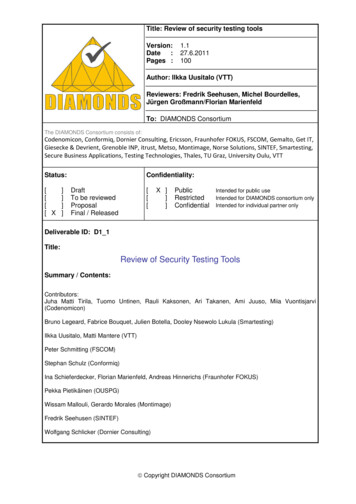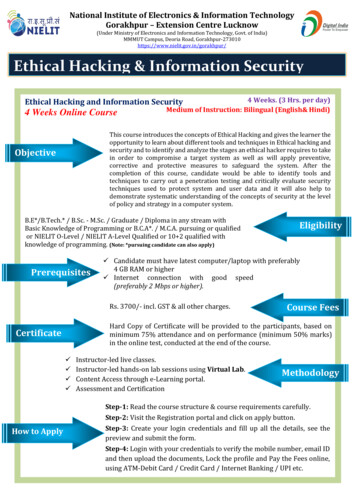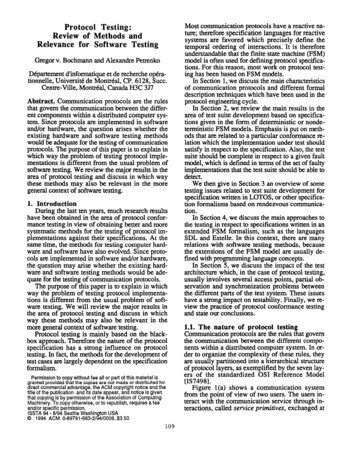
Transcription
Title: Review of security testing toolsVersion::DatePages :1.127.6.2011100Author: Ilkka Uusitalo (VTT)Reviewers: Fredrik Seehusen, Michel Bourdelles,Jürgen Großmann/Florian MarienfeldTo: DIAMONDS ConsortiumThe DIAMONDS Consortium consists of:Codenomicon, Conformiq, Dornier Consulting, Ericsson, Fraunhofer FOKUS, FSCOM, Gemalto, Get IT,Giesecke & Devrient, Grenoble INP, itrust, Metso, Montimage, Norse Solutions, SINTEF, Smartesting,Secure Business Applications, Testing Technologies, Thales, TU Graz, University Oulu, VTTStatus:[[[[ X]]]]Confidentiality:DraftTo be reviewedProposalFinal / Released[[[X ]]]PublicIntended for public useIntended for DIAMONDS consortium onlyRestrictedConfidential Intended for individual partner onlyDeliverable ID: D1 1Title:Review of Security Testing ToolsSummary / Contents:Contributors:Juha Matti Tirila, Tuomo Untinen, Rauli Kaksonen, Ari Takanen, Ami Juuso, Miia Vuontisjarvi(Codenomicon)Bruno Legeard, Fabrice Bouquet, Julien Botella, Dooley Nsewolo Lukula (Smartesting)Ilkka Uusitalo, Matti Mantere (VTT)Peter Schmitting (FSCOM)Stephan Schulz (Conformiq)Ina Schieferdecker, Florian Marienfeld, Andreas Hinnerichs (Fraunhofer FOKUS)Pekka Pietikäinen (OUSPG)Wissam Mallouli, Gerardo Morales (Montimage)Fredrik Seehusen (SINTEF)Wolfgang Schlicker (Dornier Consulting) Copyright DIAMONDS Consortium
PageReview of security testing toolsDeliverable ID: D1 1: 2 of 100Version: 1.1Date : 27.6.2011Status : FinalConfid : PublicTABLE OF CONTENTS1. Introduction . 72. Behavioral MBT for security testing . 72.1 Behavioral MBT - an introduction . 72.2 Test Design with MBT . 82.2.3 Automated Test Design with MBT in Standardization . 122.3 Modeling For automated test generation . 122.3.1 Modelling of Risk . 132.3.2 Modelling of Functionality . 132.3.3 Modelling of Security Aspects . 252.3.4 Fokus!MBT. 273. Extend test coverage using security-oriented test purposes . 313.1 Conformiq approach for testing security properties . 323.2 ETSI approach to security testbeds specific to IPv6 security testing . 323.2.1 Organization of the work . 333.2.2 Summary . 384. Random, Block-based and Model-based fuzzing . 395. Network Scanning . 445.1 port scanners. 456. Monitoring tools for detecting vulnerabilities . 466.1 Intrusion detection systems . 466.1.1 Network Based Intrusion Detection Systems . 466.1.2 Host Based Intrusion Detection Systems . 476.1.3 Scalability . 476.1.4 Challenges . 476.1.5 Examples of Current Intrusion Detection Systems. 486.2 Network monitoring tools . 516.2.1 Wireshark . 526.2.2 OpenNMS . 536.2.3 OmniPeek . 546.2.4 Clarified Analyzer . 546.2.5 Tcpxtract . 556.3 Business Activity Monitoring . 566.3.1 IBM Business Monitor . 566.3.2 Oracle Business Activity Monitoring . 576.4 database Activity Monitoring . 586.4.1 IBM InfoSphere Guardium. 586.4.2 dbWatch. 606.4.3 DB Audit 4.2.29 . 616.5 Firewalls, Spam and Virus detection tool . 636.5.1 Firewalls . 636.5.2 Virus detection . 656.5.3 Spam Detection and Filtering . 707. Diagnosis and root-cause-analysis tools . 737.1 Diagnosis tools for security testing . 737.1.1 RCAT . 73 Copyright DIAMONDS Consortium
PageReview of security testing toolsDeliverable ID: D1 1: 3 of 100Version: 1.1Date : 27.6.2011Status : FinalConfid : Public7.1.2 XFRACAS . 747.2 Intrusion prevention systems . 767.2.1 Cisco intrusion prevention system . 768. Tool integration platforms . 778.1 MODELBUS . 788.2 JAZZ. 808.3 Connected Data Objects – CDO . 818.4 EMF STORE . 829. Risk analysis and modeling tools . 839.1 Microsoft THREAT MODELING . 859.2 the coras tool . 869.3 CRAMM - CCTA Risk Analysis and Management Method and Tool . 889.4 MotOrbac. 909.5 GOAT . 929.5.1 VDC editor plugin for GOAT . 939.5.2 TSM editor plugin for GOAT . 949.6 SeaMonster . 9610. References . 97FIGURESFigure 1. The Test Design process with MBT. . 8Figure 2. Relationship between both repositories (tests and requirements). .10Figure 3. Main roles in the MBT process.11Figure 4. Model-Based Test Development [20] .12Figure 5. CORAS Tool Snapshot .13Figure 6 UML state chart with QML action language .14Figure 7. BPMN Example .15Figure 8. Example UML statechart diagram .16Figure 9. Example Object diagram .17Figure 10. UTP example of a test component definition .19Figure 11. ADML and XAML Model infrastucture .20Figure 12. System model example .21Figure 13. Behavioural system model example .21Figure 14. Test Case Designer.22Figure 15. Model-editing in Defensics .24Figure 16. Sample UMLsec Deployment Diagram .26Figure 17. UMLsec stereotypes (excerpt) [4] .26Figure 18. secureUML meta model .27Figure 18. The FOKUS!MBT modelling and test generation approach .28Figure 19. The FOKUS!MBT infrastructure .29Figure 20. Conceptual Overview of TestingMM .30Figure 21. Smartesting approach based on security test schemas . Error! Bookmark not defined.Figure 22. Card status . Error! Bookmark not defined.Figure 23. Specification-based approach .41Figure 24. Test-case generation .42 Copyright DIAMONDS Consortium
PageReview of security testing toolsDeliverable ID: D1 1: 4 of 100Version: 1.1Date : 27.6.2011Status : FinalConfid : PublicFigure 25. Test target information .43Figure 26. Step 1. Load PCAP file .44Figure 27. Step 2. Select protocol elements .44Figure 28. SNORT IPS Console .49Figure 29. OpenNMS .54Figure 30. IBM Business Monitor configuration.57Figure 31. Oracle BAM .58Figure 32. IBM InfoSphere Guardium user interface .59Figure 33. dbWatch Architecture .61Figure 34. DB audit user interface .62Figure 35. Comodo Firewall .64Figure 36. BitDefender Dashboard .67Figure 37. Antivirus Configuration .67Figure 38. Norton AntiVirus Scan .68Figure 39. Norton Insight Network .69Figure 40. Kaspersky Antivirus .70Figure 41. SPAMfighter Pro Screenshot .72Figure 42. XFRACAS user interface .75Figure 43. Cisco IPS 4270 Sensor .77Figure 44. Model Bus . Error! Bookmark not defined.Figure 45. Model Bus process . Error! Bookmark not defined.Figure 46. Jazz tool integaration . Error! Bookmark not defined.Figure 47. Connected data objects . Error! Bookmark not defined.Figure 48. EMF Store . Error! Bookmark not defined.Figure 49. Test Purpose in TPLan . Error! Bookmark not defined.Figure 50. IPv6 Test Method . Error! Bookmark not defined.Figure 51. Tunnel Mode . Error! Bookmark not defined.Figure 52. Transport Mode . Error! Bookmark not defined.Figure 53. Testbed architecture . Error! Bookmark not defined.Figure 54. Screenshot of SDL Threat Modeling Tool [52] .85Figure 55. Screenshot of the CORAS tool .87Figure 56, Screenshot of CRAMM [53] .89Figure 57. The Or-BAC model .91Figure 58. MotOrBAC user interface .92Figure 59. GOAT user interface .93Figure 60. Vulnerability detection condition for “Use of tainted value to malloc” in GOAT .94Figure 61. Graphical representation of IP blocking security rule.96Figure 62, SeaMonster screen capture .97TABLESTable 3.1: Language key words . Error! Bookmark not defined.Figure 22 Card status . Error! Bookmark not defined. Copyright DIAMONDS Consortium
PageReview of security testing toolsDeliverable ID: D1 1: 5 of 100Version: 1.1Date : 27.6.2011Status : FinalConfid : 1118.5.2011AuthorIlkka UusitaloIlkka UusitaloIlkka UusitaloIlkka UusitaloDescriptionTemplate createdFirst inputs collectedSecond round of inputs collected, first integrationFirst integration for reviewAPPLICABLE DOCUMENT LISTRef.Title, author, source, date, status1 Copyright DIAMONDS ConsortiumDIAMONDS ID
PageReview of security testing toolsDeliverable ID: D1 1: 6 of 100Version: 1.1Date : 27.6.2011Status : FinalConfid : PublicEXECUTIVE SUMMARYThe DIAMONDS project focuses on model-based security testing of networked systems to validatetheir dependability in face of malice, attack, error or mishap. Testing is the main method to reliablycheck the functionality, robustness, performance, scalability, reliability and resilience of systems asit is the only method to derive objectively characteristics of a system in its target environment. Inthis document we discuss the state-of-the art in security testing tools.Model- based Testing is the approach of deriving systematic tests on a system based on the formaldescription of system information. These models may describe the behaviour of the system, security constraints (for example access control), the security requirements, or information about possible security threats, faults or attacks. In chapter 2 we give an introduction to behavioral modelbased testing tools, an umbrella of approaches that make use of models in context of testing. TheFokus!MBT tool is discussed in more detail in chapter 2. After this, in chapter 3, Smartesting andConformiq describe their approaches for testing security properties.In Section 4 both open-source and commercial random, block-based and model-based fuzzingtools are described. Sections 5 discusses network scanning while Section 6 focuses on tools fordetecting vulnerabilities, such as IDS/IPS and network monitoring. Section 7 analyses diagnosisand root-cause analysis tools, and Section 8 is all about tool integration platforms. We concludethe document with a discussion on risk analysis and modeling tools in Section 9. of this documentdescribe different models used in security testing. Copyright DIAMONDS Consortium
PageReview of security testing toolsDeliverable ID: D1 1: 7 of 100Version: 1.1Date : 27.6.2011Status : FinalConfid : Public1. INTRODUCTIONThis document is a state of the art review on security testing tools for the Diamonds project. Thegoal of the document is to survey existing security tools from the project’s point-of-view, that is, theemphasis is on model-based security testing tools.We begin with an introduction to behavioral model-based testing, an umbrella of approaches thatmake use of models in context of testing. After this, Smartesting and Conformiq describe their approaches for testing security properties.In Section 4 both open-source and commercial random, block-based and model-based fuzzingtools are described. Sections 5 discusses network scanning while Section 6 focuses on tools fordetecting vulnerabilities, such as IDS/IPS and network monitoring. Section 7 analyses diagnosisand root-cause analysis tools, and Section 8 is all about tool integration platforms. We concludethe document with a discussion on risk analysis and modeling tools in Section 9.Static Application Security Testing (SAST) tools are out of the scope of this document.2. BEHAVIORAL MBT FOR SECURITY TESTINGTesting of security aspects is heavily tied to the operation or behaviour exhibited by a system to betested. Therefore – especially in the commercial model-based testing (MBT) tool landscape – MBTtools used for functional testing are the driver also for testing security aspects. The following sections provide a brief introduction in current MBT approaches.2.1BEHAVIORAL MBT - AN INTRODUCTIONModel-based testing (MBT) is an umbrella of approaches that makes use of models in the contextof testing. In the area of test design, model-based testing tools for assessing system behaviour infunctional testing can be categorized into the 3 main categories [1]: Test Data Generators – generate test data for the creation of logical and/or abstract testcases Test Case Editors – tools, which, based on an abstract model of a test-case, creates one ormore test-cases for manual execution or test scripts for automated execution Test Case Generators - tools, which, automatically, create test-cases, test scripts or, even,complete test suites, using configurable coverage criteria, based on a model of the systembehaviour, the system environment or of tests and specific control informationThere are several reasons for the growing interest in using model-based testing: The complexity of software applications continues to increase, and the user’s aversion tosoftware defects is greater than ever, so our functional testing has to become more andmore effective at detecting bugs; The cost and time of testing is already a major proportion of many projects (sometimes exceeding the costs of development), so there is a strong push to investigate methods likeMBT that can decrease the overall cost of test by designing as well as executing tests automatically; Copyright DIAMONDS Consortium
PageReview of security testing toolsDeliverable ID: D1 1: 8 of 100Version: 1.1Date : 27.6.2011Status : FinalConfid : Public The MBT approach and the associated tools are now mature enough to be applied in manyapplication areas, and empirical evidence is showing that they can give a good ROI.Model-based testing renews the whole process of functional software testing: from requirements tothe test repository, with manual or automated test execution. It supports the phases of designingand generating tests, documenting the test repository, producing and maintaining the bi-directionaltraceability matrix between tests and requirements, and accelerating test automation.This section addresses these points by giving a realistic overview of model-based testing and itsexpected benefits. It discusses what model-based testing is, how you have to organize a processand a team to use MBT, and which benefits it may expect from this software testing approach.2.2TEST DESIGN WITH MBTTest design with model-based testing refers to the processes and techniques for the automaticderivation of abstract test cases from abstract formal models, via the generation of concrete testsfrom abstract tests, and to the manual or automated execution of the resulting concrete test cases.Therefore, the key points of automated test design with model-based testing are the modeling principles for test generation, the test generation strategies and techniques, and the implementation ofabstract tests into concrete, executable tests. A typical deployment of MBT in industry goesthrough the four stages shown in Figure 1:Figure 1. The Test Design process with MBT.1. Design a functional test model. The model, sometimes called the test model, representsthe expected operational behavior of the system under test (SUT) or the system environment or usage. The choice must be done by the controls and observations elements provided by the SUT. Standard modeling languages such as UML can be used to formalize thecontrol points and observation points of the system, the expected dynamic behavior of thesystem, the entities associated with the test, and some data for the initial test configuration.Model elements such as transitions or decisions are linked to the requirements, in order to Copyright DIAMONDS Consortium
PageReview of security testing toolsDeliverable ID: D1 1: 9 of 100Version: 1.1Date : 27.6.2011Status : FinalConfid : Publicensure bi-directional traceability between the requirements and the model, and later to thegenerated test cases. Models must be precise and complete enough to allow automatedderivation of tests from these models;2. Select some test generation criteria. There are usually an infinite number of possibletests that could be generated from a model, so the test analyst chooses some test selectioncriteria to select the highest-priority tests, or to ensure good coverage of the system behaviors. One common kind of test selection criteria is based on structural model coverage, using well known test design strategies such as equivalence partitioning, cause-effect testing,pairwise testing, process cycle coverage, or boundary value analysis (see [1] for more details on these strategies). Another useful kind of test generation criteria ensures that thegenerated test cases cover all the requirements, possibly with more tests generated for requirements that have a higher level of risk. In this way, model-based testing can be used toimplement a requirement and risk-based testing approach. For example, for a non-criticalapplication, the test analyst may choose to generate just one test for each of the nominalbehaviors in the model and each of the main error cases; but for one of the more critical requirements, she/he could apply more demanding coverage criteria to ensure that this partof the test model is more thoroughly tested;3. Generate the tests. This is a fully automated process that generates the required numberof (abstract) test cases from the test model. Each generated test case is typically a sequence of high-level SUT actions, with input parameters and expected output values foreach action. These generated test sequences are similar to the high-level test sequencesthat would be designed manually in action-word testing [2]. They are easily understood byhumans and are complete enough to be directly executed on the SUT by a manual tester.The test model allows computing the expected results and the input parameters. Data tables may be used to link some abstract value from the model with some concrete test value. To make them executable using a test automation tool, a further concretization phaseautomatically translates each abstract test case into a concrete (executable) script [3], using a user-defined mapping from abstract data values to concrete SUT values, and a mapping from abstract operations into test adaptation API calls. For example, if the test execution is via the GUI of the SUT, then the action words are linked to the graphical object mapusing a test robot – in this case the test adaptation. If the test execution of the SUT is APIbased, then the action words need to be implemented on this API. This can be a directmapping or a more complex adaptation layer. The expected results part of each abstracttest case is translated into oracle code that will check the SUT outputs and decides automatically on a test pass/fail verdict. The tests generated from the test model may be structured into multiple test suites, and publishe
Conformiq describe their approaches for testing security properties. In Section 4 both open-source and commercial random, block-based and model-based fuzzing tools are described. Sections 5 discusses network scanning while Section 6 focuses on tools for detecting vulnerabilities, such as IDS/IPS and network monitoring. Section 7 analyses diagnosis











